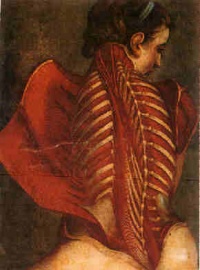Flaying
From The Art and Popular Culture Encyclopedia
|
Related e |
|
Featured: |
Flaying also known colloquially as Skinning is the removal of skin from the body. Generally, an attempt is made to keep the removed portion of skin intact.
Contents |
Scope
An animal may be flayed in preparation for human consumption, or for its hide or fur; this is more commonly called skinning. Flaying of humans is used as a method of torture or execution, depending on how much of the skin is removed. This article deals with flaying in the sense of torture and execution. This is often referred to as "flaying alive." There are also records of people flayed after death, generally as a means of debasing the corpse of a prominent enemy or criminal, sometimes related to religious beliefs (e.g. to deny an afterlife); sometimes the skin is used, again for deterrence, magical uses, etc. (e.g. scalping).
History
Flaying is an ancient practice. There are accounts of Assyrians flaying a captured enemy or rebellious ruler and nailing the flayed skin to the wall of his city, as a warning to all who would defy their power. An Assyrian torture practice consisted of indirectly punishing a person by flaying his young child before his eyes. The Aztecs of Mexico flayed victims of ritual human sacrifice, generally after death. Searing or cutting the flesh from the body was sometimes used as part of the public execution of traitors in medieval Europe. A similar mode of execution was used as late as the early 18th century in France; one such episode is graphically recounted in the opening chapter of Michel Foucault's Discipline and Punish (1979). The Subprior and the Sacrist of Westminster Abbey broke into the Chapel of the Pyx in 1303, the abbey muniment and treasury chamber, and stole from the contents. The Pyx chapel door has been found to have fragments of human skin attached to it as have the three doors to the revestry. The Copford church in Essex, England has been found to have human skin attached to a door. In Chinese history, Sun Hao, Fu Sheng and Gao Heng were known for removing skin from people's faces. The Hongwu Emperor flayed many servants, officials and rebels. In 1396 he ordered the flaying of 5000 women. Hai Rui suggested that his emperor flay corrupt officials. The Zhengde Emperor flayed six rebels, and Zhang Xianzhong also flayed many people. Lu Xun said the Ming Dynasty was begun and ended by flaying.
Examples of flayings
- Yahu-Bihdi, ruler of Hamath, was flayed alive by the Assyrians under Sargon II.
- According to Herodotus, Sisamnes, a corrupt judge under Cambyses II of Persia, was flayed alive for accepting a bribe.
- In Greek mythology, Marsyas, a satyr, was flayed alive for daring to challenge Apollo.
- Also according to Greek mythology, Aloeus is said to have had his wife flayed alive.
- Tradition holds that Saint Bartholomew was flayed before being crucified.
- In Aztec mythology, Xipe Totec is the flayed god of death and rebirth. Slaves were flayed annually as sacrifices to him.
- The Talmud discusses how Rabbi Akiva was flayed by the Romans for the public teaching of Torah.
- Mani, founding prophet of Manichaeism, was said to have been flayed or beheaded (c. 275).
- Totila is said to have ordered the bishop of Perugia, Herculanus, to be flayed when he captured that city in 549.
- Pierre Basile was flayed alive and all defenders of the chateau hanged on 6 April 1199, by order of the mercenary leader Mercadier, for shooting and killing King Richard I of England with a crossbow at the siege of Chalus in March 1199.
- In 1314, the brothers d'Aulnoy, who were lovers to the daughters-in-law of king Philip IV of France, were flayed alive, then castrated and beheaded; and their bodies were exposed on a gibbet. The extreme severity of their punishment was due to the lèse majesté nature of the crime.
- The Polish Jesuit Saint Andrew Bobola was burned, half strangled, partly flayed alive and killed by a sabre stroke by Eastern Orthodox Cossacks
- In a particularly acute example of deadpan, Jonathan Swift's narrator in "A Tale of a Tub" says, "Last week I saw a woman flay’d, and you will hardly believe how much it alter'd her person for the worse".
- One of the plastinated exhibits in Body Worlds includes an entire posthumously flayed skin, and many of the other exhibits have had their skin removed.
- In 991 AD during a Viking raid in England, a Danish Viking was flayed by London locals for ransacking a church.
- Daskalogiannis, a Cretan rebel against the Ottoman Empire, was flayed alive and it is said that he suffered in dignified silence.
- The Rawhide Valley in Wyoming is said to have gotten its name from a white settler who was flayed alive there for murdering a Native American woman.
- Marcantonio Bragadin, last Venetian governor of Cyprus, was flayed alive after the Conquest of Famagusta by the Turks.
- Krokodeilos Kladas, a military leader flayed by the Turks.
- In medieval Turkey, convicted pirates were slowly tortured to death by being flayed alive.
- In 1404 or 1417, the Hurufi Imad ud-Din Nesîmî, an Islamic poet of Turkic extraction, was flayed alive, apparently on orders of a Timurid governor, and for heresy.
- St. Teodor of Vršac, Serbian Orthodox Bishop of Vršac, was flayed alive in 1594 by the Ottomans, under order of Grand Vezier Sinan Pasha, for leading the Serbs in the Banat Uprising.
- In the United States, Nat Turner was hanged on November 11, 1831. His body was then flayed, beheaded, and quartered.
- In Haruki Murakami’s novel The Wind-Up Bird Chronicle (1994-1995), the character Mamiya is traumatised by having witnessed a colleague being flayed to death in Manchukuo in the late 1930s.
See also
- Anthropodermic bibliopegy (books bound in human skin)


